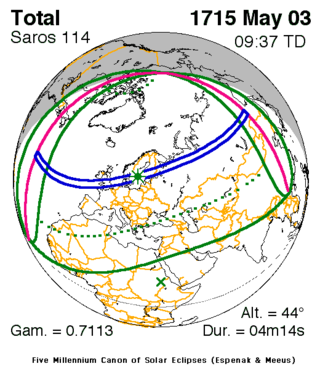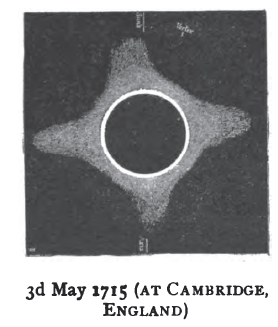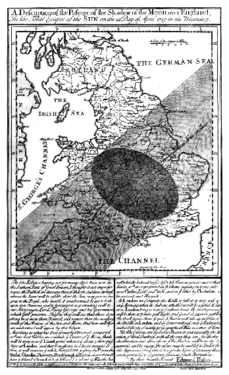Solar eclipse of May 3, 1715

The wide (faint) shadow shows for the penumbra (partiality), and the smaller dark shadow shows for the umbra (totality).
| Solar eclipse of May 3, 1715 | |
|---|---|
| Type of eclipse | |
| Nature | Total |
| Gamma | 0.7112 |
| Magnitude | 1.0632 |
| Maximum eclipse | |
| Duration | 254 s (4 min 14 s) |
| Coordinates | 59°24′N 17°54′E / 59.4°N 17.9°E |
| Max. width of band | 295 km (183 mi) |
| Times (UTC) | |
| Greatest eclipse | 9:36:30 |
| References | |
| Saros | 114 (60 of 72) |
| Catalog # (SE5000) | 8826 |
A total solar eclipse occurred on 3 May 1715. It was known as Halley's Eclipse, after Edmond Halley (1656–1742) who predicted this eclipse to within 4 minutes accuracy. Halley observed the eclipse from London where the city of London enjoyed 3 minutes 33 seconds of totality. He also drew a predictive map showing the path of totality across the Kingdom of Great Britain. The original map was about 20 miles off the observed eclipse path, mainly due to his use of inaccurate lunar ephemeris. After the eclipse, he corrected the eclipse path, and added the path and description of the 1724 total solar eclipse.[1]
Drawing upon lunar tables made by the first Astronomer Royal John Flamsteed, William Whiston produced a more technical predictive eclipse map around the same time as Halley. Both Halley's and Whiston's maps were published by John Senex in March 1715.[2][3]
Totality was observed in the Kingdom of Great Britain from Cornwall in the south-west to Lincolnshire and Norfolk in the east. It was also observed in Ireland, where large crowds turned out in Dublin to watch it: the weather in Dublin was exceptionally cold and wet, and the eminent judge Joseph Deane caught a fatal chill as a result,[4] although Elrington Ball more prosaically states that his death was probably due to gout.[5]
Note: Great Britain did not adopt the Gregorian calendar until 1752, so the date was at the time considered 22 April 1715.
|
Related eclipses[edit]
It is a part of Solar Saros 114.
See also[edit]
References[edit]
- ^ Westfall, John; Sheehan, William (2014). Celestial Shadows: Eclipses, Transits, and Occultations. Springer. p. 115. ISBN 978-1-4939-1535-4.
- ^ Pasachoff, J. M. (1999) "Halley and his maps of the Total Eclipses of 1715 and 1724" Journal of Astronomical History and Heritage (ISSN 1440-2807), Vol. 2, No. 1, p. 39–54
- ^ Rebekah Higgitt (3 May 2015). "Halley's Eclipse: a coup for Newtonian prediction and the selling of science". The Guardian.
- ^ Mason, William Monck The History and Antiquities of the Collegiate and Cathedral Church of St. Patrick's Dublin Dublin 1820
- ^ Ball, F. Elrington The Judges in Ireland 1221-1921 John Murray London 1926
External links[edit]
- Total Eclipses of the Sun, By Mabel Loomis Todd, 1894, new and revised edition by David Peck Todd, 1900.
- Halley's eclipse Hans van der Meer's Eclipse Page
- [1] Halley is credited with the first eclipse map showing the path of the Moon's shadow across England during the upcoming total eclipse of 1715.
- Halley's Maps and Descriptions of the 1715 Total Solar Eclipse
- [2] [3] Edmund Halley, Observations of the Late Total Eclipse of the Sun on the 22d of April Last Past, Made before the Royal Society at Their House in Crane-Court in Fleet-Street, London. by Dr. Edmund Halley, Reg. Soc. Secr. with an Account of What Has Been Communicated from Abroad concerning the Same, Phil Trans R Soc 1714 29: 245–262.
- Whiston's predictive map of March 1715
Further reading[edit]
- Walters, A.N. (1999) "English Broadsides of Early Eighteenth-century Solar Eclipses"







